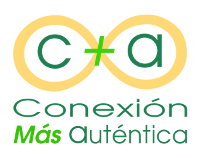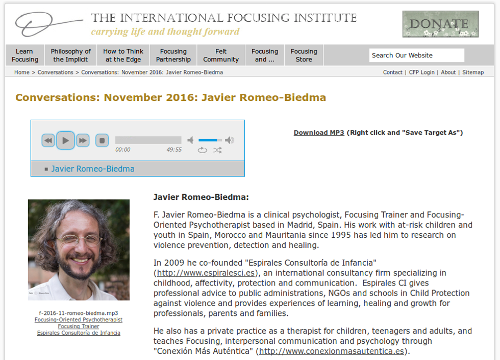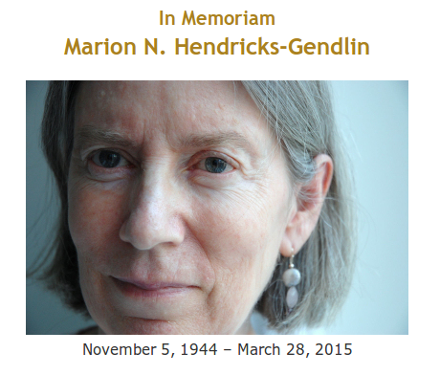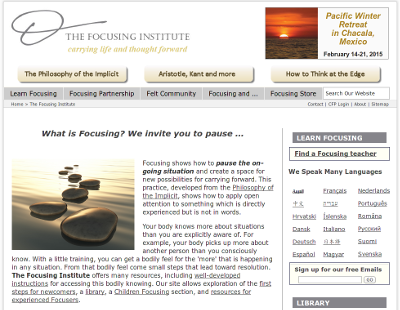Label: In English
My interview about “Focusing and how to work experientially with violence” for The International Focusing Institute
14 November 2016.
Tags: Agenda actual, CI Spirals, Focusing, Focusing international, In English, My Classifieds, Psychotherapy, Therapy, Textos Focusing, Experiences
A deep sense of honour and a distinct feeling of humility and shyness come to me when I share this interview. I can feel clearly the responsibility of talking about the work I do about “Focusing and how to work experientially with violence”, as the title of the conversation says. It is an important subject for me (I work a lot about it through Spiral Consulting Children, the international consulting firm specializing in Child Protection I co-founded), and trying to convey all its nuances is always a challenge.
The International Focusing Institute (the organization that coordinates internationally Focusing activities related to training and diffusion) fosters bimonthly “Conversations” with Focusing professionals all over the world. Serge Prengel, a Focusing Trainer and Focusing-Oriented Psychotherapist that I met at the International Focusing Conference 2016 in Cambridge (UK), acts as the host, and he does so in a very Focusing way –reflecting, with pauses, letting new ideas appear and develop in their own time.
In this “Conversation” you will find discussed issues like the following ones:
- Violence as a stopped process (“Something should have happened to carry forward a situation, and it did not occur, so the process gets stuck”).
- Harm defines violence, and harm is lived from the body.
- Finding a handle for violence (identifying it) is the first step out of it: becoming aware of our cultural patterns that normalize violence.
- The role of power in violence.
- Affection linked to care as a way to avoid violence –and the bodily dimension that can be reached through Focusing.
- Violence detection and intervention in Child Protection.
- A message of hope about healing and transforming violence, and Focusing as a wonderful tool to do it.
I hope that you will find an idea or two that might inspire your own experiential work about violence, and I will love to hear from you about it.
Read this entry in Spanish (although the interview itself is in English).
The Community Wellness Focusing Interest Group at the Focusing Conference in Cambridge (UK) 2016
7 November 2016.
Tags: Focusing community, Focusing, Focusing in Spain, Focusing international, In English, Textos Focusing, Experiences
The Community Wellness Focusing Interest Group was for me one of the highlights of the International Focusing Conference in Cambridge (UK) July 20th-27th 2016. It was an experience of co-creating a community through listening, translation, our previous communities and Focusing attitude.
Some months have passed, and I have been writing about my experiences at the Conference (all posts indexed in this post in Spanish), and a warm and tender feeling comes to me when I remember this Group. Every morning during the Conference all participants joined one of the 15 Interest Groups. These were groups intended to be an open space to share personal and professional perspectives about Focusing in specific domains. I was tempted by many of the titles (there was even a “No-interest Interest Group”!) and I am very happy about my choice, while I regret not being able to split myself in order to attend to many others…
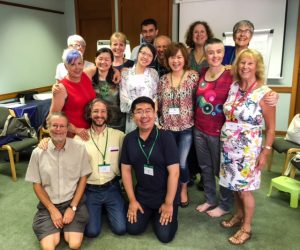
Community Wellness Focusing Interest Group at the International Focusing Conference, Cambridge (RU), July 2016.
The Community Wellness Focusing Group was hosted by Nina Joy Lawrence, Pat Omidian and Heidrun Essler, who created a holding space for all of us to participate and, as they advanced, “to bring Focusing skills and attitudes into our daily lives and into community groups” –including our own group. Thank you!
The first element was listening. We were sixteen participants from six different countries (Afghanistan, China, Germany, Spain, UK and USA), and not everybody was fluent in English, so the first step to build our community was to ensure that everyone could express themselves and understand anything that was said: that meant that we ended using three different working languages (English, Chinese and Spanish). What could have been a burden (translating, for example, what a Chinese participant said to English, and then to Spanish, and then replying in English, and then translating to Chinese and to Spanish, and so on) became a precious gift: the possibility to listen to each other from a deep Focusing attitude, even before the words were translated. So we cultivated a slow-paced way of being together, a space where everyone was listening to people speaking in foreign languages and, somehow, at the end, we were starting to understand each other’s experience before translation.
A second experience that was very moving for me was translation itself. I have been translating in different settings and from different languages for over two decades, and very usually in professional settings (for example, translating foreign Focusing trainers here in Spain). But for me translating a Focusing conversation always brings a special effort, how to translate both the words and the implicit experience in those words.
That took me to a different level: the fact that I was translating (English and Spanish, both ways) in a group that felt like a community reminded me of how I used to translate immigrant teenagers for group-building in an association that no longer exists. When I shared that experience of both satisfaction about being able to translate in a community setting and grief about the disappeared association, other fellow members shared about the communities they had lost too –and how our previous communities were present and had a space in what we were creating.
During those four sessions we talked, tried exercises, commented, discussed… As I shared in the final row, I had arrived to the group with the main goal of getting ideas, techniques and exercises to create a community that uses Focusing. However, I have taken away something very different: a Focusing attitude that fosters presence, that allows the group and each of its members to attend to a different quality of feeling, a connection that is kept in the body.
Those are some learnings that will stay for me (in fact I have visited Focusing Initiatives International, the organization that helps spread Community Wellness Focusing, and I have joined the Community Wellness Focusing Discussion List), as well as a deep gratitude toward our hosts and every member of the group. Now is the time to carry all these experiences forward creating communities with this Focusing attitude.
I wish for those of you who read me deep experiences of community-building like this.
Note: Picture posted with the permission of the members. No personal names are given in respect for their privacy, apart from the hosts that publicly offered the Interest Group.
Ideas from “Conversations at the Edge” with Gene Gendlin and Ann Weiser Cornell 2016
25 October 2016.
Tags: Focusing community, Focusing, Focusing international, In English, Textos Focusing, Experiences
Gratitude, awe and humbleness – those feelings stand up among all the rest after attending the latest course with Gene Gendlin and Ann Weiser Cornell about Focusing, the Philosophy of the Implicit and Gendlin’s work.
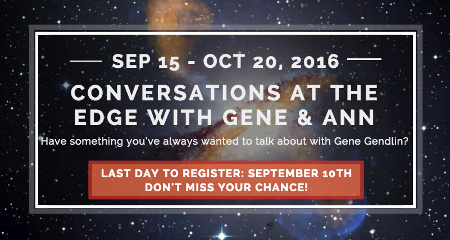 I am deeply grateful for having had the opportunity to join “Conversations at the Edge with Gene and Ann” during these past weeks of September and October 2016. Ann Weiser Cornell has been organizing these “Conversations at the Edge with Gene and Ann” several times a year through her platform Focusing Resources as a phone course by Gene Gendlin and herself in which participants can ask whatever they want: questions for Gene Gendlin, requests for ideas and even to be accompanied through a Focusing process by Gendlin himself.
I am deeply grateful for having had the opportunity to join “Conversations at the Edge with Gene and Ann” during these past weeks of September and October 2016. Ann Weiser Cornell has been organizing these “Conversations at the Edge with Gene and Ann” several times a year through her platform Focusing Resources as a phone course by Gene Gendlin and herself in which participants can ask whatever they want: questions for Gene Gendlin, requests for ideas and even to be accompanied through a Focusing process by Gendlin himself.
 Gratitude, awe, humbleness… I had already listened to audio and video files of Gene Gendlin, and I have found them very inspirational. But being with him in a conversation over the phone is something profoundly different. Even if I did not dare to ask anything during the first three sessions, listening to him interacting live with other people has a special quality. His presence, his openness, his clarity are very moving, and he shares his wisdom with some pearls of his knowledge and his attention.
Gratitude, awe, humbleness… I had already listened to audio and video files of Gene Gendlin, and I have found them very inspirational. But being with him in a conversation over the phone is something profoundly different. Even if I did not dare to ask anything during the first three sessions, listening to him interacting live with other people has a special quality. His presence, his openness, his clarity are very moving, and he shares his wisdom with some pearls of his knowledge and his attention.
And I want to share some of the ideas that I enjoyed the most:
- The concept of crossing, summarized by Gene: “Crossing makes it possible to say anything and be understood in some new way by saying it in a new system, saying ‘How is this (or can be) an instance of that?'” We can always say anything by expressing it from another point of view. A metaphor is possible by saying one thing in function of another: “A is, in a certain sense, B.”
- A fascinating discussion between Gene and a participant about how to define Focusing, and his objection about defining the necessary and sufficient for something to be Focusing. One of the many ideas is that “Focusing is staying with ‘that’, even when there is no relief yet.”
- Focusing as a way to listen to our inner movements: “There is a lot in us that wants to be heard and has not been heard yet. What is in me that wants to be heard?”
- A bright message of hope: “Focusing does not need trust [in the process] in advance,” meaning that we can start a Focusing process even distrusting something in us, and through the process we will arrive to trust it.
- Gene sharing that he considers himself “very biased in favour of keeping the good things and leaving the bad things apart,” meaning that he prefers to stay with the pleasant aspects of each process and not insisting and trying to “understand” (in the head) the painful aspects, once the process has solved them: “You do not need to go there,” he said.
- “Focusing is a technique, but not only a technique.”
- Focusing is always an inner process, even when we are Focusing on external objects (trees, landscapes, paintings…): there is always a body feeling.
- The formulation “Let’s stay a minute with that,” letting the word “that” contain all the meanings, without specific words, so when words come, they will be new and fresh.
- Talking about how a culture can configure a person’s experiences, Gene said: “Every human being is always more than their culture.”
- “The felt-sense is always more reliable than emotion or logic/reason alone.”
And I have a special memory of talking with Gene about my approach to find a handle for violence with Focusing, so we can all detect and prevent it, as I usually teach in my trainings for Child Protection professionals (social workers, psychologists, educators, teachers…) and families, and feeling his interest and receiving his support and encouragement.
There were many other interactions plenty of interesting ideas and experiences, with the presence of Gene and Ann. I keep them with care, and private.
So I feel gratitude, awe and humbleness for having spent these hours listening to Gene Gendlin live, with his warmth, his openness, his curiosity, his deep interest in what each participant had to ask or share. A true lesson. An inspiration. And a celebration.
I send from here my gratitude to Gene for being available and to Ann for making it possible at all levels.
With gratitude, awe and humbleness,
Focusing workshop on prevention of violence at the International Conference Focusing 2016 Cambridge (United Kingdom)
23 July 2016.
Tags: Agenda filed, CI Spirals, Focusing, Training, In English, Psychotherapy, Therapy
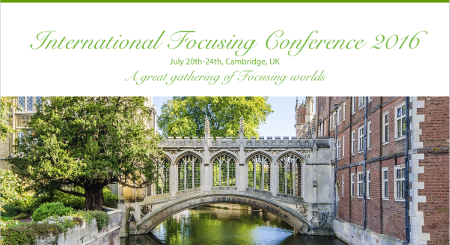 Taller “Finding a Handle for Violence In Our Lives” (“Finding a foothold for the violence in our lives”) on the application of Focusing for the prevention of violence in 27ª International Conference on Focusing of 2016 Cambridge (United Kingdom), organized by the British Focusing Association, and open to members of the International Focusing Institute (The Focusing Institute) of all the world.
Taller “Finding a Handle for Violence In Our Lives” (“Finding a foothold for the violence in our lives”) on the application of Focusing for the prevention of violence in 27ª International Conference on Focusing of 2016 Cambridge (United Kingdom), organized by the British Focusing Association, and open to members of the International Focusing Institute (The Focusing Institute) of all the world.
Date: New date: sábado 23 July 2016, of 11:00 a 13:00.
Place: Robinson College
Cambridge
United Kingdom
Description: When we work with children, adolescence and youth, with populations at social risk, in social intervention environments, with clients in therapy, we can see the effects that violence has on their lives. In this workshop we are going to work in an experiential way to find a foothold for violence in our own lives as a first step to prevent and detect situations of violence.. We are going to explore how to identify violence from a Focusing body perspective to empower ourselves –and thus transform the violence around us–.
Addressed to: professionals (of psychology, of therapeutic intervention, of Education, of social work, etc.) who work with children, girls, adolescents and young people, with populations at social risk, with clients in therapy; people working for social change (in associations, foundations, etc.); and general public interested in managing violence in new ways.
facilitator:
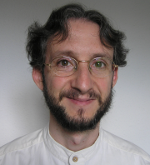 F. Javier Romeo-Biedma is a clinical psychologist, is certified as a Focusing Trainer and as a Focusing-Oriented Psychotherapist, en Madrid, Spain, and is an international consultant on Child Protection, Affectivity and Interpersonal Communication in Spiral Consulting Children (an international consulting company that trains and advises on Child Protection). Your work with children, girls, adolescents and young people at social risk in Spain, Morocco and Mauritania have led him to investigate prevention, detection and healing of violence (and that includes a deep experience in Nonviolent Communication). He also practices psychotherapy and teaches Focusing, Nonviolent Communication and Psychology in More Authentic Connection. He has given training in Spanish (your mother tongue), English, French and Moroccan Arabic.
F. Javier Romeo-Biedma is a clinical psychologist, is certified as a Focusing Trainer and as a Focusing-Oriented Psychotherapist, en Madrid, Spain, and is an international consultant on Child Protection, Affectivity and Interpersonal Communication in Spiral Consulting Children (an international consulting company that trains and advises on Child Protection). Your work with children, girls, adolescents and young people at social risk in Spain, Morocco and Mauritania have led him to investigate prevention, detection and healing of violence (and that includes a deep experience in Nonviolent Communication). He also practices psychotherapy and teaches Focusing, Nonviolent Communication and Psychology in More Authentic Connection. He has given training in Spanish (your mother tongue), English, French and Moroccan Arabic.
[Original entry 27 May 2016, actualizada a 23 July 2016, date of the workshop].
Workshop “Finding a Handle for Violence In Our Lives” at the International Focusing Conference 2016, Cambridge (UK)
23 July 2016.
Tags: Agenda filed, CI Spirals, Focusing, Training, In English, Psychotherapy, Therapy
 Workshop “Finding a Handle for Violence In Our Lives” at the 27th International Focusing Conference 2016 in Cambridge (UK), organised by the British Focusing Association, open to members of The Focusing Institute from all over the world.
Workshop “Finding a Handle for Violence In Our Lives” at the 27th International Focusing Conference 2016 in Cambridge (UK), organised by the British Focusing Association, open to members of The Focusing Institute from all over the world.
Dates: New date: Saturday 23rd July 2016, from 11:00 to 13:00.
Place: Robinson College
Cambridge
United Kingdom
Description: When we work with children and youth, with at-risk populations, in social settings, with clients in therapy, we can see the effects of violence in their lives. In this workshop we will work experientially to find a handle for violence in our own lives, as the first step to prevent and detect situations of violence. We will explore how to identify violence from a Focusing and embodied perspective to empower ourselves –transforming violence around us.
Target audience: professionals (psychologists, therapists, educators, social workers, etc.) working with children and youth, with at-risk populations, with clients in therapy; people working for social change (associations, foundations, etc.); and general public interested in dealing with violence in new ways.
Facilitator:
 F. Javier Romeo-Biedma is a clinical psychologist, Certified Focusing Trainer and Psychotherapist based in Madrid, Spain, and an international consultant on Child Protection, Affectivity and Communication at Spiral Consulting Children (an international consultancy firm he co-founded that provides training and assessment in Child Protection). His work with at-risk children and youth in Spain, Morocco and Mauritania has led him to research on violence prevention, detection and healing (including a deep experience in Nonviolent Communication). He also has a private practice and teaches Focusing, Nonviolent Communication and Psychotherapy at More Authentic Connection. He has taught in Spanish (his mother tongue), English, French and Moroccan Arabic.
F. Javier Romeo-Biedma is a clinical psychologist, Certified Focusing Trainer and Psychotherapist based in Madrid, Spain, and an international consultant on Child Protection, Affectivity and Communication at Spiral Consulting Children (an international consultancy firm he co-founded that provides training and assessment in Child Protection). His work with at-risk children and youth in Spain, Morocco and Mauritania has led him to research on violence prevention, detection and healing (including a deep experience in Nonviolent Communication). He also has a private practice and teaches Focusing, Nonviolent Communication and Psychotherapy at More Authentic Connection. He has taught in Spanish (his mother tongue), English, French and Moroccan Arabic.
See this same entry in Spanish.
[Original post of May 27th. 2016, updated on July 23rd. 2016, date of the workshop].
“Connect with Respect” (“Respect for Me, Respect for You”), Bridget Belgrave material for Nonviolent Communication work with adolescents and young
18 September 2015.
Tags: CNV, Interpersonal communication, Education, Training, In English, Texts CNV, Videos
Last weekend 12 and 13 September 2015 I have had the privilege and pleasure of working again Bridget Belgrave. As I mentioned in this post, I met Bridget Belgrave already Gina Lawrie, Certified trainers for the Center for Nonviolent Communication (Center for NonViolent Communication, CNVC), in 2009 and from that moment we began to work together to translate NVC Dance Floors the Castilian. Completed translations finally saw the light in 2014, with some illustrative videos that can be viewed I made this entry for release. Association for Nonviolent Communication It has organized a series of training courses in Madrid, Bilbao and Barcelona during September 2015, and for me it has been a pleasure to work again with Bridget Belgrave support team with the translation from English into Castilian and vice versa.
In preparing the workshop I have spent time reviewing all the materials I have the NVC Dance Floors and of Bridget en particular. And valuing all materials, each with its wealth, there is one that is still my favorite. In fact, Bridget invited me to share my vision at some point of the workshop, and I happened also to extend my recommendation in this blog.
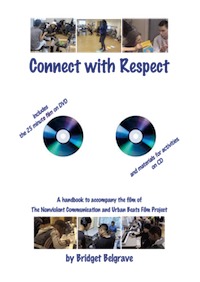 The material in question is only in English and not have subtitles or translations available, but I hope that does not discourage approach him. “Connect with Respect” (“Connect on respect”, literally translated into Castilian) is a multimedia material documenting a project that made Bridget Belgrave 2004 with 21 adolescents and young adults with an average age of seventeen. The project was proposed as an intervention to train boys and girls in situations of social difficulty Nonviolent Communication, within the framework of a workshop building urban rhythms, for ten weeks.
The material in question is only in English and not have subtitles or translations available, but I hope that does not discourage approach him. “Connect with Respect” (“Connect on respect”, literally translated into Castilian) is a multimedia material documenting a project that made Bridget Belgrave 2004 with 21 adolescents and young adults with an average age of seventeen. The project was proposed as an intervention to train boys and girls in situations of social difficulty Nonviolent Communication, within the framework of a workshop building urban rhythms, for ten weeks.
Why recommend? Here is a summary of my reasons:
- The DVD with the film, of 25 minute. Collect the key moments of the project, recorded therefore the three trainers as by young people themselves, and edited in collaboration with them. In fact, as told in a passage, the fact of viewing previous sessions helped them all become more aware of their own learning and getting behaviors that would be well suited to the needs of everyone. It is a graph document lets put faces (and sounds) to different situations, and lets figure out how to apply it in other contexts.
- The video is supplemented with the second part of the book, “Guide to the Film” (“Guide for the film”), on which sequence by sequence discussed everything that happens: each situation, how teaches Nonviolent Communication, Practice times, the real conflicts that arise… This will better understand the intent of each activity and the difficulties encountered and how they were addressed.
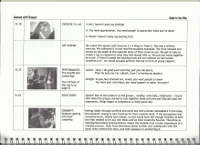
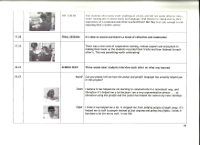
- And the third part of the book contains the complete program, ten weeks with all their detailed exercises and all materials also typeset (English), as well as incorporating a CD-ROM with the file of each material in PDF ready to print. Obviously the video does not collect all the exercises, so it is very useful to see the progression activity to activity, with the ability to replicate.
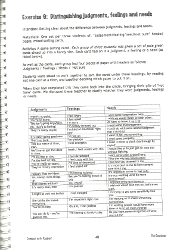
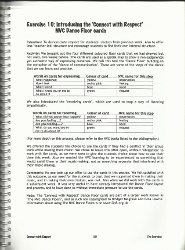
- The availability of a translation of what the Dance floor itself to Castilian, with title “Respect for Me, Respect for You”, within the complete package Dance Floors.
- And the caveat Bridget Belgrave not attempt a project of this type without having one hand a strong background and experience in Nonviolent Communication, and secondly an educational team with some basis of CNV and experienced in working with adolescents. I made some of these exercises with adolescents and youth at risk in Madrid and went well, so I'm available.
In summary, a material worth seeing, read, reread and implement. And you can buy in its online store, Life Resources.
And if you want more clarification, You can call me on my phone contact and discuss what you want.
I hope we can soon have more projects of this style here!
Xavier
Restorative Practices at school, a new way to resolve conflicts
5 May 2015.
Tags: CNV, Interpersonal communication, Education, In English, For parents, Texts CNV, Other Texts, Videos, Webs
Most disputes can be resolved in a satisfactory and beneficial way for all parties, provided that the necessary resources and time are dedicated. That's my personal and professional experience years learning, practicing and transmitting Nonviolent Communication. It's as basic (not easy) as the necessary conditions for that resolution occurs. For me there are several must-haves, which can be summarized as follows:
- An appropriate methodology, to allow all parties involved feel safe and respected in their rights.
- Professionals with experiential training in mediation and deep listening skills and “translation” messages to make them easier to listen to each person.
- A supportive community restorative processes, devoting time, spaces, human Resources, training…
- People willing to resolve conflicts in a way that ultimately all parties feel heard and that all parties leave satisfied with the solution.
So for me it is a joy to share the resources developed by a large community of people in the neighborhood are Gotleu in Palma de Mallorca (Mallorca), They are collecting and how they have worked each of those elements.
In this video you can see how they have been involved, with the revitalization of Institute for Coexistence and School Success (the Institute for Coexistence and School Success in Castilian) Government of the Balearic Islands, from the faculty of schools of Primary Education, Elementary and Secondary, students of all ages, the families, and Social Services, police, University and other significant social groups. A mosaic of voices, We make us an idea of the experiences of the creation of that network security in a socially vulnerable environment, and we see some results.
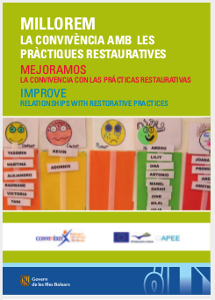 For a more systematic view, is the publication containing the fundamentals. Published in Catalan, Castilian and English as part of a European project this subject, the Guide to improve coexistence with Restorative Practices / Guide Mejoramos coexistence with the practices restorative develops the theoretical aspects of Restorative Practices, more accurate data and provides concrete examples and suggestions for further reading for more information.
For a more systematic view, is the publication containing the fundamentals. Published in Catalan, Castilian and English as part of a European project this subject, the Guide to improve coexistence with Restorative Practices / Guide Mejoramos coexistence with the practices restorative develops the theoretical aspects of Restorative Practices, more accurate data and provides concrete examples and suggestions for further reading for more information.
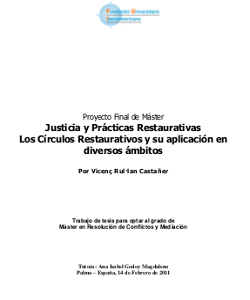 And to deepen the Restorative Circles, a practice of conflict resolution originated in the social dimension Nonviolent Communication, you can read the interesting monograph Justice and Restorative Practices. Restorative Circles and their application in various fields, written by Vicenç Rul·lan, a trainer who I have the pleasure of meeting, on the video and in the Guide, and he is a member of the Association of Restorative Justice Practices and Islands (to page Castilian and in Catalan, with several resources more). A good introduction, to further deepen this particular model. And you can also watch videos (English) on the official website of the creator of the Restorative Circles, Dominic Barter, RestorativeCircles.org.
And to deepen the Restorative Circles, a practice of conflict resolution originated in the social dimension Nonviolent Communication, you can read the interesting monograph Justice and Restorative Practices. Restorative Circles and their application in various fields, written by Vicenç Rul·lan, a trainer who I have the pleasure of meeting, on the video and in the Guide, and he is a member of the Association of Restorative Justice Practices and Islands (to page Castilian and in Catalan, with several resources more). A good introduction, to further deepen this particular model. And you can also watch videos (English) on the official website of the creator of the Restorative Circles, Dominic Barter, RestorativeCircles.org.
Who have done some training of interpersonal communication with me you have seen that ground mention this issue of Restorative Practices. I hope these resources illustrate a little better what you have heard me and I hope to awaken your creativity and your imagination to continue discovering more effective and deeper ways to resolve conflicts in the educational environment, and in any other area.
Xavier
En memoria de Mary Hendricks-Gendlin, Focusing reference
14 April 2015.
Tags: Focusing, In English, Psychotherapy, Therapy, Textos Focusing, Experiences, Webs
Last 28 March 2015 Marion died (better known as “Mary”) N. Hendricks-Gendlin, an essential reference for the Focusing. I am among those who, without having known directly, We receive the inheritance of his work and his spirit.
Mary Hendricks-Gendlin fue, among other aspects of your life, psychologist, Focusing psychotherapist Orientation, founding member The Focusing Institute (Focusing Institute of New York) and director of it for many years. It has also been the partner of Gene Gendlin, who shaped the focusing process and continues to live, and the mother of Elissa, the daughter they had together.
For me the reference of Mary Hendricks-Gendlin comes mainly through Isabel Gascón, Focusing Spanish coordinator and my trainer Reference (after I certificate, I'm still learning it in every contact we have, personal or professional). Isabel Gascón, for its long history and its representation Focusing Institute Focusing Spanish for international issues (especially as vice president), He has had much contact with Mary, even in recent years, when Gene and Mary have left the address The Focusing Institute (Focusing Institute of New York). Precisely, a week before the death of Mary, in the National Conference Focusing 2015 Miraflores de la Sierra, Saturday 21, Isabel Gascón was commenting us several participants their experience of Mary and Gene, with love and tenderness, and from the admiration of all who have made both, supporting each other. I recommend reading the tribute of Isabel Gascón on their website.
Inheritance we receive not have known who directly takes many forms:
- A Focusing Institute solid, Mary and Gene have led to a transition to a new organization adjusted to the reality of international and multidisciplinary Focusing.
- Focusing international distribution, that she has been instrumental during his time as director. It seems essential to your article “Felt Sense Literacy” (also available in Spanish as “Literacy felt sense”), Focusing a moving vision as a force for social transformation.
- Support for the creation of such important aspects for Focusing and groups “Changes” (“changes”), Focusing groups sharing between practitioners.
- His current research in various areas of Focusing, Counseling and psychotherapy with Focusing and “Thinking At the Edge -TAE” (“Thinking From the Edge – PDB”).
- His concept “Revolutionary pause”, that is to give us time before acting, before to answer, to stop and see how our body lives every situation. In this way we can achieve greater authenticity of decisions. You can read his impressive article “Focusing as a Force for Peace: The Revolutionary Pause” (English only for now), wherein the first lines are poignant in its simplicity and depth, and where the rest of the text develops from different points of view the concept of “Revolutionary pause”.
From here goes my gratitude to Mary Hendricks-Gendlin and my tribute to his life and his work, who have also touched my life. And my love and care to Gene Gendlin and to all those who have loved Mary, and they have lost not only an essential professional, but also to a master, companion and dear friend, as revealed by the comments of the tribute page The Focusing Institute.
With respect and care,
Xavier
Website Focusing Institute of New York (The Focusing Institute)
7 October 2014.
Tags: Focusing, In English, Textos Focusing, Webs
A basic resource to know Focusing is the website of the New York Focusing Institute, The Focusing Institute. The Institute is the entity that coordinates at the international level the dissemination of Focusing and the international certification of Focusing professionals. With this intention, the website has abundant resources within the most relevant aspects.
It has a section in español, where several introductory texts about Focusing and some applications appear, including my article “Combining Focusing and Nonviolent Communication: Reflecting deeper implications for”.
the main page, what is in english, has different sections, including:
- How to learn Focusing (Learn Focusing).
- What is being done in the Focusing community (Felt Community), with a newsletter (Newsletter) that appears several times a year and The Folio. A Journal for Focusing and Experiential Therapy, the official academic journal.
- Focusing applications and combinations in different environments and for different audiences (Focusing and…).
- The online store (Focusing Store), where you can see buy from the main books, videos and audios, although most of the texts in Spanish are better found on the website of the Focusing Spanish Institute.
The Eugene Gendlin Online Library is especially interesting (Gendlin Online Library), where you can open access to the original version (in english or german) of hundreds of articles you have published the main author of Focusing, and where you can also read a lot about the more philosophical aspect of this tool, the Philosophy of the Implicit (The Philosophy of the Implicit).
I invite you to investigate and discover resources on this page, dedicating the time it deserves.
I hope you find it as enriching as it is for me.
Xavier
NVC Dance Floors: practice Nonviolent Communication in a holistic manner
25 September 2014.
Tags: CNV, Interpersonal communication, Education, In English, My Classifieds, For Teens, For boys and girls, For parents, Psychotherapy, Therapy, Texts CNV, Videos
The NVC Dance Floors have already appeared in the version in Castilian, in which I have worked, and are also available videos subtitled in Spanish.
Bridget Belgrave and Gina Lawrie, Certified trainers for the Center for Nonviolent Communication (Center for NonViolent Communication, CNVC), years they created a great tool to teach and practice Nonviolent Communication (CNV). As they themselves have in submission, the NVC Dance Floors (NVC Dance Floors) They emerged through a series of steps to facilitate the practice of Nonviolent Communication with a spatial maps that allow use body size to work the emotional dimension, the way you see in this video:
In summer 2009 formarme had the pleasure to meet with Gina and Bridget, From there already work resumed translation and adaptation to the Castilian, an effort in which we have helped many people and I have coordinated for a while. So it is a pleasure to spread a simple tool and yet so deep, finally in Spanish, in which we care to include the largest possible number of Spanish version.
My experience is that the NVC Dance Floors the people can practice with just a few initial knowledge of Nonviolent Communication (In fact I sometimes use in introductory workshops). Even people who do not know the process of Nonviolent Communication itself (children, and adolescents, therapy clients) They can easily cross it with help from someone more experienced.
The NVC Dance Floors combine the visual, corporal and language, so that experience occurs through more channels and experience is deeper. And there are nine “dances” different, with names such as “The Dance of the 13 Steps”, “Integration and Dance Connection”, “The Dance of Anger / Rage, Shame and Depression”, “Dance of Yes and No”, The “Transform the pain of unmet needs in the Beauty Needs”.
Further, in 2013 they released some videos that explain three of these dances, in a neat edition that includes Spanish subtitles.
If you want to buy the dance floor CNV in different formats (as a download in PDF, on paper, plasticized version…) and DVDs to learn them at home or in group practice, you can visit its online store, Life Resources.
And if you want to count on me to try the dance floor in one session or in specific workshops, I will be happy to accompany.
I hope you like.
Xavier
